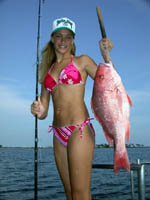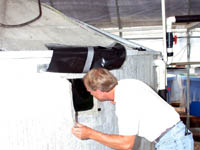
|
Features
|
|
|
|
Books
|
|
|
|
Fun & Games
|
|
|
|
Contact Us
|
|
|
John's Journal... Entry 232, Day 5
SNAPPER BONANZA
Snapper As An Aquaculture Fish
 Editor's
Note: The recovery of red snapper in the Gulf of Mexico and possibly worldwide
may occur much quicker than previously predicted, thanks to a small group
of scientists at the Claude Peteet Mariculture Center in Gulf Shores,
Alabama. New scientific breakthroughs in artificially spawning snapper,
producing microscopic-sized food for baby snapper, training snapper to
eat commercially-prepared food, creating an artificial habitat that speeds
up the reproduction cycle of the red snapper and constructing a new salt-water
pipeline from the Gulf of Mexico to the Mariculture Center may result
in the Center's producing 100,000 red snapper per year for restocking
and research within the next five years.
Editor's
Note: The recovery of red snapper in the Gulf of Mexico and possibly worldwide
may occur much quicker than previously predicted, thanks to a small group
of scientists at the Claude Peteet Mariculture Center in Gulf Shores,
Alabama. New scientific breakthroughs in artificially spawning snapper,
producing microscopic-sized food for baby snapper, training snapper to
eat commercially-prepared food, creating an artificial habitat that speeds
up the reproduction cycle of the red snapper and constructing a new salt-water
pipeline from the Gulf of Mexico to the Mariculture Center may result
in the Center's producing 100,000 red snapper per year for restocking
and research within the next five years.
 The
red snapper is known worldwide as a delicacy and has a tremendous commercial
appeal. As the research continues to develop for growing red snapper in
saltwater ponds, the aquaculture industry is watching with a keen eye.
However, the quota for the commercial harvest of wild red snapper won't
change for awhile. If snapper can be raised in saltwater ponds, through
aquaculture techniques, then snapper may be able to be raised and sold
like catfish are today. The demand for red snapper is much higher than
commercial snapper fishing can supply. Skeptics aren't willing to believe
that a group of scientists, based out of the Claude Petit Mariculture
Center in south Alabama, can raise and stock enough red snapper to have
a significant positive impact on increasing the number of snapper in the
Gulf. But, Vernon Minton, the director of the Marine Resources Division
of Alabama's Department of Conservation, quickly points out, "Look what
the marine biologists in Texas have done with their restocking efforts
of red drum (redfish) and spotted seatrout. Texas has been stocking bays
and estuaries with these two fish, and the catches of these two fish coming
from the bays and estuaries that have been stocked have shown very positive
returns for these stocking efforts."
The
red snapper is known worldwide as a delicacy and has a tremendous commercial
appeal. As the research continues to develop for growing red snapper in
saltwater ponds, the aquaculture industry is watching with a keen eye.
However, the quota for the commercial harvest of wild red snapper won't
change for awhile. If snapper can be raised in saltwater ponds, through
aquaculture techniques, then snapper may be able to be raised and sold
like catfish are today. The demand for red snapper is much higher than
commercial snapper fishing can supply. Skeptics aren't willing to believe
that a group of scientists, based out of the Claude Petit Mariculture
Center in south Alabama, can raise and stock enough red snapper to have
a significant positive impact on increasing the number of snapper in the
Gulf. But, Vernon Minton, the director of the Marine Resources Division
of Alabama's Department of Conservation, quickly points out, "Look what
the marine biologists in Texas have done with their restocking efforts
of red drum (redfish) and spotted seatrout. Texas has been stocking bays
and estuaries with these two fish, and the catches of these two fish coming
from the bays and estuaries that have been stocked have shown very positive
returns for these stocking efforts."
 Can
restocking of red snapper have the same positive impact offshore that
restocking has had in Texas for inshore species? Minton's answer is, "We
need to find out. Even if offshore stocking of red snapper does not produce
the positive results that are anticipated, we still have a very positive
program that may be able to help the aqua culture industry produce and
grow more red snapper for human consumption."
Can
restocking of red snapper have the same positive impact offshore that
restocking has had in Texas for inshore species? Minton's answer is, "We
need to find out. Even if offshore stocking of red snapper does not produce
the positive results that are anticipated, we still have a very positive
program that may be able to help the aqua culture industry produce and
grow more red snapper for human consumption."
To learn more about this program at the Marine Resources Division, e-mail Minton at rvminton@gulftel.com, and you also can visit www.dcnr.state.al.us/mr/cpmc.htm on the Web.
Check back each day this week for more about SNAPPER BONANZA ...
Day 1 - The Future Has Arrived
Day 2 - The Problem With Raising Captive
Red Snapper: Producing Food For the Fry
Day 3 - Two Ways To Spawn Snapper: Artificially
and By Creating Habitat
Day 4 - The Future of Red Snapper
Day 5 - Snapper As An Aquaculture Fish